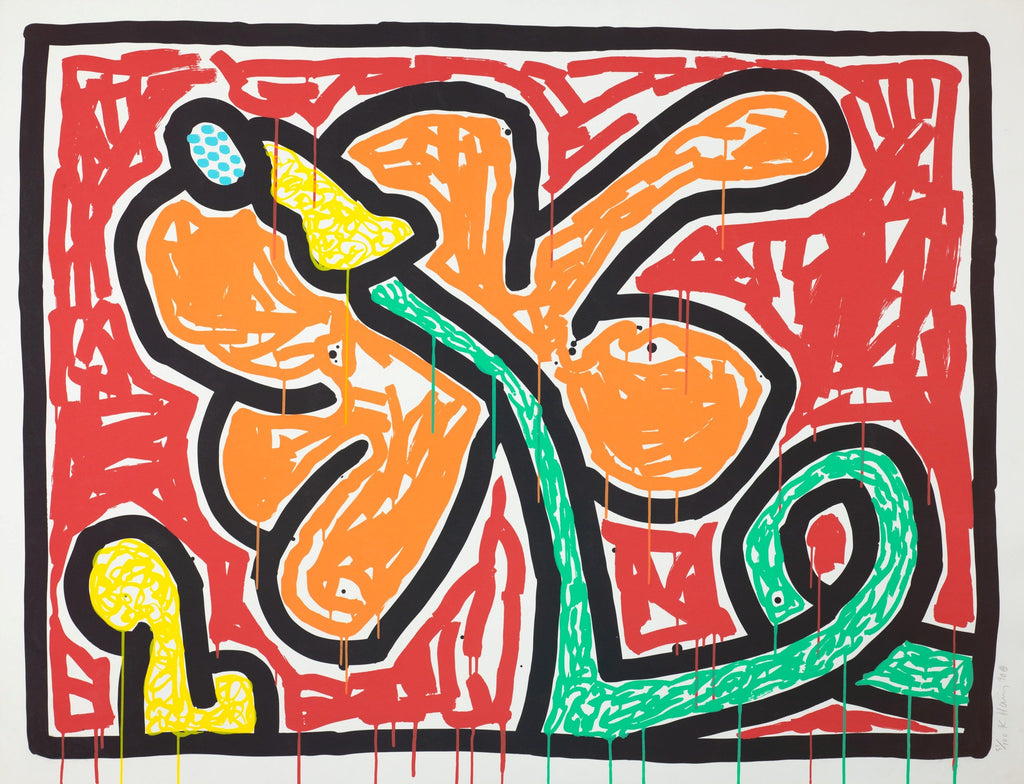Upload a photo of your space
For best results we recommend marking 10 inches on your wall with tape to get a sense of scale. Make sure to have the floor visible in the photo.





About the Work
"Flowers (Red)" is a silkscreen on Wove paper created by Keith Haring in 1990. From the edition of 133, the artwork is signed and dated 'K. Haring '90' vertical lower right. The image size is 39.12 x 50.87" and the artwork is framed in a contemporary black frame. The artwork ships framed and accompanied by a certificate of authenticity.
Keith Haring (1958–1990) remains one of the most vital and beloved figures in contemporary art — a visionary who transformed the language of visual culture through his bold lines, direct symbolism, and unwavering commitment to accessibility. From the New York City subway system to the world’s leading museums, Haring’s work endures as a universal emblem of optimism, social engagement, and the power of art to communicate across boundaries. Created in the final year of his life, the Flowers series — five monumental screenprints — stands confidently among the most visually compelling statements of his career.
Flowers, 1990 (Red) is a large-format screenprint measuring 39 by 51 inches. At its center, a monumental orange flower with a vivid green stem rises against a dynamic red ground. Bounded by Haring’s signature black line border and punctuated with passages of bright yellow, the composition pulses with energy and immediacy. Unlike Haring’s typically flat expanses of color, the colorations here are not solid blocks of color, or even the allover pattern-making he is known for. Instead, he has filled in his colors in a painterly manner, emitting a gestural impact. This treatment gives the print a sense of texture and motion, lending the flower an almost tactile vitality.
Notably, the work also features uniform vertical drip marks running in the same direction across the entire surface. Far from incidental, these drips were created deliberately as part of the printing process for every impression in the edition. Their regularity underscores the tension between the mechanical repetition of printmaking and the spontaneous, expressive qualities that define Haring’s imagery.
Haring’s Flowers series reimagines one of art’s most enduring symbols: the flower as a sign of life, beauty, and renewal. In the context of Haring’s life — facing his own mortality amid the AIDS crisis — the motif becomes a poignant emblem of resilience and affirmation. Stripped to its essential contours, the flower becomes an icon that transcends personal narrative to touch something universal. It is a celebration of simplicity, joy, and the dignity of the handmade mark — even within the process of mechanical reproduction.
The flower is among the most powerful of all human symbols—an image of growth, transformation, and remembrance. In Haring’s hands, it becomes a sign of hope that transcends time and place. This is a work to be prized not only for its striking visual presence but for the singular vision it embodies: an artist meeting the end of life with generosity, clarity, and a belief in the power of images to comfort and inspire.
About the Artist
Keith Haring was a social activist and artist who wasn’t afraid to depict and publicize controversial topics such as war, sexuality, life, and death with his art. Haring used New York City - the walls, stations, and buildings - as his canvas, creating masterpieces for the public eye. His signature cartoon style combined his outspoken political and social activism place Haring amongst the legends in the art world. Born May 4, 1958, in Reading, Pennsylvania, Haring grew up fascinated by the cartoon art of Walt Disney, Charles Schultz, and even Dr. Seuss. Haring’s father also drew cartoons as a hobby in his free time, inspiring a young Haring to perhaps make his own one day. Eventually, as a grown man, he moved to New York City to enroll at the School of Visual Arts. It is there Haring found his artistic peers and social niche and became acquainted with Jean-Michel Basquiat and Kenny Scharf, among other individuals in the underground art scene.
Please utilize the AR experience in a well-lit room.
Scan the room for surface detection.

Artwork will place in your room.
Using your fingers, align the horizontal white line
with your floor.

Double tap the artwork to scale to 100% size
and pinch to move on the screen.









